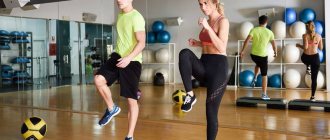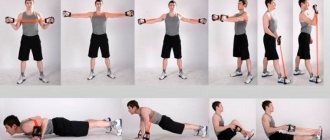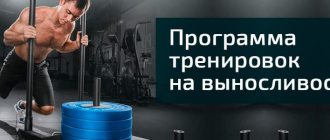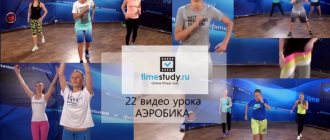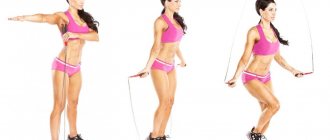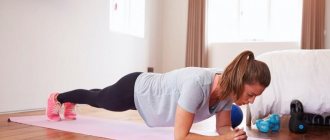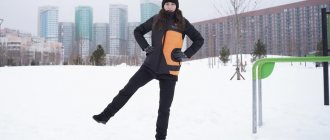You can improve your running performance through several aspects: improving technique and increasing muscle strength. For these purposes, SBU (special running exercises) were developed. Specifically running exercises are an undeniable tool for improving athletic performance for all track and field athletes who engage in running.
Special running exercises should be performed not only by professional runners, but also by amateurs. In general, everyone who runs in any of its variations.
Special running exercises - what are they?
In general, all exercises, including those for runners, can be divided into two large groups - general and special. The former influence the result, but indirectly, while the latter are necessary specifically to improve technique and enhance sportsmanship in general. The fact is that general exercises develop general physical fitness, and special exercises develop only those muscles and skills that are needed for running.
To increase the strength and endurance of the muscles involved in running, you can train with weights in the gym. But these are completely different conditions than running, so the result will be much worse.
Special running exercises were developed not only to strengthen certain muscle groups, but also to develop the correct patterns. Each special running exercise represents a separate element of running, but, as a rule, with an emphasis on its execution.
Why perform SBU
Special running exercises are used for three purposes:
1. As part of a warm-up, to activate and warm up target muscle groups. The length and intensity of the exercises will be small (20-40 m; 1-2 series).
2. As a means of correcting running technique. Obviously, it is extremely important for beginners to perform SBUs in every workout. Correction of physical deficiencies in running technique should take place while the body is fresh and adequately responds to a small load (40-50 m; 2-3 series).
3. As a means of special physical training for a runner. For example, the “deer run” exercise is often used as the main block in training, and is performed in repetitions of 8 to 12 times at maximum intensity, lasting from 60 to 100 m. This type of training is used by trained athletes to develop strength endurance.
A set of special running exercises
A set of special running exercises is a program that is designed for training amateur athletes. Be sure to read the recommendations for the complex and the technique of performing each exercise.
Running with hops
Tasks. Increases foot muscle strength and improves overall coordination.
When performed with circular movements of the arms, the shoulder girdle warms up. Especially the deltoids, chest and back muscles. Technique. Jumps are performed alternately: first on one leg, then on the second. Hands are relaxed. Or they perform circular movements, thereby stretching the shoulder girdle and some back muscles.
Main mistakes: alternate jumping from one foot to another, landing on the heel, chaotic movement of the arms.
Running with high knees
Tasks. Strengthens the quadriceps, hip flexors and improves coordination.
This exercise is suitable for runners who roll their shins too far back or don’t lift their hips high enough. Technique. The legs are raised high up until the thighs are parallel to the surface of the ground. Flexion occurs at the knee and hip joints. The emphasis should be on lifting your foot off the floor rather than planting it. The body must be in a vertical position.
Main mistakes: thigh below or above parallel to the floor, poor posture, emphasis on foot placement.
Running with shin splints
Tasks. Warm up the knees, strengthen the hamstrings.
Technique. The work is performed only in the knee joint, the feet are thrown back until they touch the buttocks. The torso needs to be slightly tilted. This is especially true for those who have poor quadriceps stretching. But in general, the exercise is suitable even for beginners; it’s not for nothing that we all performed it in physical education lessons.
Main mistakes: insufficient amplitude. moving the legs forward, bending the body strongly.
Rolling from heel to toe
Tasks. Improving the neuromuscular connection of the muscles that are involved in pushing.
Technique. The movement should start from the heel. Try to apply the force through your thumb. This is followed by landing on the back (push) leg. The exercise is performed alternately. The torso should be vertical. The position of the hands is not a fundamental aspect. You should land softly, without strong impacts.
Main mistakes: hard landing, uncoordinated actions.
Running backwards
Tasks. Practicing the skills of bending the shin and pushing the leg off the ground.
Technique. The body should be tilted slightly forward. Steps should be as large as possible. As much as possible. The arms move in the same way as during normal running.
Main mistakes: small steps, strictly vertical body.
Running with straight legs
Tasks. Some special running exercises in athletics are aimed at strengthening the foot.
This is one of them. It is also suitable for strengthening the iliopsoas muscle. Technique. When landing, the foot must be tense. There should be no relaxation, otherwise you may get injured. The body is in a vertical position. The height of the lift depends on the goal: the higher, the more the iliopsoas muscle works and the push-off is honed. And vice versa, the lower the leg is raised, the more the foot is loaded and the landing is practiced.
Main mistakes: bending the front leg at the knee joint, landing on a loose foot.
Running sideways with side steps
Tasks. Working on the soleus, gastrocnemius and foot muscles.
Technique. We also did this exercise in physical education lessons. The main thing in lateral running with side steps is the transfer of body weight to the leg, which is brought to the side. The arms are spread to the sides and brought back. The position of the hands must be changed with each jump.
Main mistakes: incorrect position of the hands, lack of transfer of body weight to the extended leg.
Delayed leg raise
Tasks. Improved coordination, strengthened core and hamstring muscles.
Technique. The thigh must be moved up to an angle of 90 degrees in relation to the body. At the knee joint, the leg is bent as much as possible. The exercise is similar to running with high knees. But at the top point you need to pause and bend your shin all the way. The exercise is performed alternately on each leg. The upward movement is fast and explosive, and the downward movement is moderate and soft.
Main mistakes: tilting the body forward or backward, rigidly lowering the raised leg down, insufficient or exaggerated lifting of the hip.
Walking on toes with straight leg extension
Tasks. Working out the calf muscles is the main task.
Strengthening your core muscles is secondary. Technique. The leg that is carried forward bends only at the hip joint. It is important to maintain correct posture and pull your toes towards you. The hand of the same name should hang freely in the air. The second one needs to touch the toe. The exercise is very stretching intensive. If the required level of flexibility has not yet been achieved, then the element with the hand touching the toe can be removed and the leg can be raised as much as possible while maintaining the correct technique.
Main mistakes: incorrect posture, pulling the toe forward, bending the knee joint of the front leg.
Multi-leaps or “deer running”
Tasks. Strengthening the muscles of the back of the thigh and a fairly large load on the calf muscles.
Technique. The exercise looks like jumping from one leg to the other. When jumping up, you should fully straighten the leg that made the push. The second leg is brought forward. The knee joint is bent. You should land on your entire foot. Use your hands to maintain balance. The body is in a vertical position, but if it is not comfortable, a slight tilt is still allowed.
Basic mistakes: landing on your heel or toe, not straightening the knee joint of the pushing leg when jumping.
Multi-jump and running step
Tasks. Improved coordination and neuromuscular communication.
Technique. The exercise is performed as the previous one. Only after landing is a running step taken, and not the same movement, but on the other leg. After the step, you need to quickly get into work and perform an explosive jump. You can't hesitate. The exercise is difficult. Therefore, you will have to spend a lot of time mastering the correct technique. But this one is worth it. The ability to alternate between relaxing and tensing muscles is an important skill for a runner.
Main mistakes: delay after a step and the same mistakes as in the last exercise.
Running exercises
PREVIOUS
Self-control and exercise. Stage 1.
General warm-up. Stage 1.
Stretching. Stage 1.
Warm-up while running. Stage 1. (Gym or street)
When warming up while running, you must strictly adhere to several rules regarding running without doing exercises:
- Running is always done on the toes... more precisely, the heel never touches the floor;
- In running, the feet are turned slightly inward so that the push-off occurs with all the toes, and not just the big ones;
- While running, unless an exercise is performed that eliminates this condition, the shoulders never rise and, together with the neck, are completely relaxed;
- The gaze is always straight ahead at horizon level;
- Breathing is deep and even. For three steps, inhale through your nose, for three steps, exhale through your mouth.
- Breathing is carried out from the lower abdomen.
- While running, we consciously feel the floor and the force of its recoil.
- We don’t “fall” to the floor after each push, but flutter, touching the floor with our feet.
These conditions are required for all running warm-ups, with the exception of exercises that exclude any of the conditions. In the conditions of performing such exercises, these exceptions will be specified by me.
Exercise No. 1. Easy running in a circle.
Execution:
- Running is performed on toes, the heel does not touch the floor;
Execution time: 6 minutes.
Conditions:
- In running, the feet are turned slightly inward so that the push-off occurs with all the toes, and not just the big ones;
- While running, the shoulders never rise and, together with the neck, are completely relaxed;
- The gaze is always straight ahead at horizon level;
- Breathing is deep and even. For three steps, inhale through your nose, for three steps, exhale through your mouth.
- Breathing is carried out from the lower abdomen.
- While running, we consciously feel the floor and the force of its recoil.
- We don’t “fall” to the floor after each push, but flutter, touching the floor with our feet.
Exercise No. 2. Side step running.
Execution:
- Turning to the left (uncomfortable) side in the direction of movement, we run by pushing the rear leg to the floor and moving the front leg forward and pulling the back leg to the front (in the direction of movement) for the next push-off;
Execution time: 1 minute with the left side and 1 minute with the right.
Conditions: Head turned in the direction of movement, gaze forward. Hands in a fighting position (riken-chudan). For each kick of the leg, exhale.
Exercise No. 3. Run backwards.
Execution:
- Turning your back forward in the direction of movement, we run.
Completion time: 1 minute - look forward over your left shoulder and 1 minute - over your right.
Conditions: The head is turned in the direction of movement, looking forward (first over one (inconvenient) shoulder, then over the other. Hands in a fighting position (riken-chudan).
Exercise No. 4. Run.
Execution: see Exercise No. 1.
Execution time: 1 minute.
Conditions: see Exercise No. 1.
Exercise No. 5. Running with a high hip lift.
Execution:
- At a fast pace while running, in the direction of movement we perform a high rise of the hips to the chest;
Execution time: 1 minute.
Conditions: Hands in a fighting position (riken-chudan). Exhale for each leg lift.
Exercise No. 6. Running with shin overlapping.
Execution:
- At a fast pace while running, we perform shin overlappings in the direction of movement. Hands in a fighting position (riken-chudan).
Execution time: 1 minute.
Conditions: Exhale for each leg sweep. The heels reach the buttocks.
Exercise No. 7. Running with scissors.
Execution:
- At a fast pace while running, we swing with straight legs in front of us as we move. Hands in a fighting position (riken-chudan).
Execution time: 1 minute.
Conditions: Exhale for each leg swing. The feet rise above the knee.
On topic: Treadmill training program
Exercise No. 8. Jumping below.
Execution:
- In a squat, we jump forward on two legs. Hands in a fighting position (riken-chudan).
Execution time: 1 minute.
Conditions: For each kick, exhale. The push is performed simultaneously with both legs. Looking forward to the horizon.
Exercise No. 9. Jumping sideways below.
Execution:
- In a squat, turning sideways in the direction of movement, we perform jumps on two legs, moving sideways forward. Hands in a fighting position (riken-chudan). The head is turned forward in the direction of movement. Look ahead.
Execution time: 1 minute with the right side, 1 minute with the left.
Conditions: For each kick, exhale. The push is performed simultaneously with both legs. Looking forward to the horizon.
Exercise No. 10. "Goose step"
Execution:
- In a squat, we move forward by alternately moving our legs forward. Hands in a fighting position (riken-chudan).
Execution time: 1 minute.
Conditions: Breathing is free. Looking forward to the horizon. The center of gravity does not shift vertically (the head remains at the same level during movement).
After completing the last exercise, we immediately move on to performing “lower acrobatics”.
Source: https://www.sakura-karate-do.ru/uprazhneniya-v-bege
Recommendations for the complex
Recommendations for the complex are needed to clarify some seemingly insignificant or obvious, but very important points. Follow these tips:
- Warm up thoroughly before each workout. A joint warm-up and light stretching will be enough.
- The exercises in the complex are arranged from the easiest to the most difficult. It's better to start with those that are simpler.
- The number of approaches and repetitions depends on training, regimen, frequency of training and many other factors. Start with one or two sets of each exercise per week and gradually increase the volume. The number of repetitions should be such that there is no strong acidification, and the execution technique remains correct. But doing it more than 30 times is impractical.
- If you perform several approaches in an exercise, then you should not dilute it with another movement. This will harm the quality of execution and reduce the efficiency of equipment development.
- At first it is very important to concentrate on the correct technique. When the exercise is brought to automatism, it will become easier.
- The complex should be performed after a running workout.
- Some exercises require good stretching. Therefore, after the main part of the workout, work on the flexibility of your legs. 2-3 times a week will be enough.
I will give an example to make it clearer for you. You have 3 running workouts per week (Monday, Wednesday, Friday). At first, the complex should be performed only after one of the workouts. Let's say on Monday. Do all the exercises, but one approach at a time. This way you will master the technique faster.
After a couple of weeks or even a month, do the complex after two workouts (Monday and Friday). After another month, perform the exercises after each training session. After that you can start increasing the number of approaches. But systematically and without unnecessary haste.
Exercises should be performed in shoes designed for running. The best place to practice running exercises is a stadium with a special coating. But if it is not possible to train in such conditions, then it’s okay. The main thing is to take care of good shoes.


